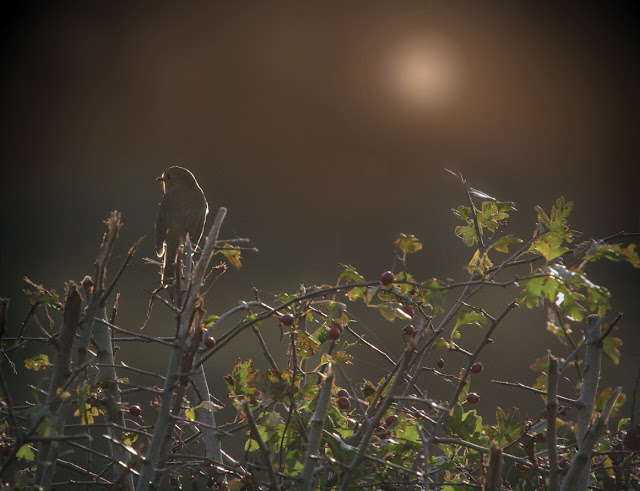The bird itself is, of course, stunning in its simple beauty, but I also love the triangular framing of the foliage and the echoes of yellow in the background.
Technical information: Canon 1Ds MkII, Canon 100-400mm IS USM L-series lens, 1.500th sec, f/5.6, 400mm at ISO 800
20110930
Spider consuming a ladybird
These feel, I think, like truly intimate shots, providing a fascinating view of life and death in a tiny, almost alien environment of which we are so often oblivious. When I caught sight of the House Spider (Araneus diadematus) suspended between reeds with its trapped prey, I knew I had to try to capture it. While to the naked eye little detail was visible, I knew if I could get close enough a whole new world would open up. There were issues with this however. Negotiating ever closer to the spider without triggering any movement of any part of the web was difficult; the reeds were thick and the wider web was complex. The brilliant light meant getting the exposure right was a challenge and the slightest breeze sent the spider and its ladybird lunch into a frantic swaying motion. Finally, capturing the reverse of the scene (shown in the second picture) meant shooting directly into the sun, the challenge being to render detail in the shot without losing any of the atmosphere.
- Technical notes: the shots were taken using a Canon 100mm image stabilized f/2.8 macro lens. In each shot, a medium aperture setting (f11 and f18 respectively) was used to maximise crispness in the details. The downside to this was, with the camera hand-held, that the slower shutter speeds (just 1/85th sec in the second shot) meant several takes were needed before motion blur was eliminated.
 |
| Canon 1Ds MkII, Canon 100mm 2.8 IS Macro lens, 1/400th sec, f/11, 100mm at ISO 500 |
 |
| Canon 1Ds MkII, Canon 100mm 2.8 IS Macro lens, 1/85th sec, f/18, 100mm at ISO 800 |
Gone fishing…
I was monitoring this Black-winged Stilt at the Pensthorpe reserve here in Norfolk when its probing of the water happened on this tiny fish. It took the fish further into its beak and then, just as it seemed to be considering downing it in one, it popped it back into the water. The Stilt (Himantopus himantopus) – which, from a little research, I see bred in the UK for the first time in 2008 – usually selects crustaceans and insects from the menu, so I can only assume this lucky fish was simply not to its liking.
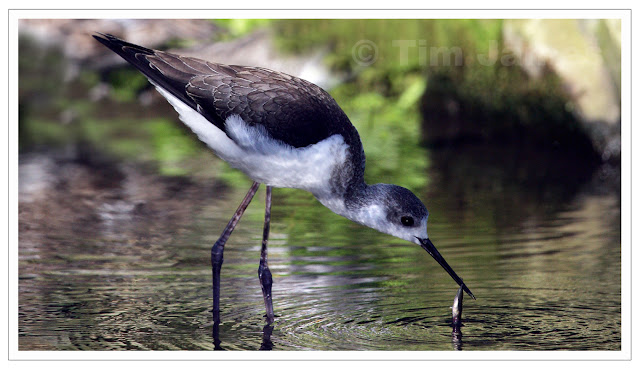 |
| Canon 1Ds MkII, Canon 100-400mm IS USM lens, 1/2,700th sec, f/5.6, 400mm at ISO 800 |
 |
| Canon 1Ds MkII, Canon 100-400mm IS USM lens, 1/2,700th sec, f/5.6, 400mm at ISO 800 |
20110927
Cobweb
This image is, I think, proof that beauty is all around us. I noticed the strands of pearls glistening in the early morning dew as I left to do the school run. If anything the light had improved by the time I got back and the intricate web – spun between the uprights of a cast-iron gate in the garden – was perfectly showcased. One cannot help but be in awe of the dedication and 'engineering'. For those keen on the more technical side of things, two elements facilitated the image. The first was to ensure (by simply moving around until all was set) that the silver web was set against a dark background. The second was to close the aperture somewhat (in this case to f/13) to ensure crisp details and a wider area of focus.
 |
| Canon 1Ds MkII, Canon 100-400mm IS USM lens, 1/160th sec, f/13, 400mm at ISO 400 |
20110926
Early autumn leaves
I was struck by the simple beauty of this composition, the veins and saw-tooth outlines of the leaves thrown into stark relief by the late evening sun. If I remember, I will try to shoot the same branch from the same position over the coming few weeks in an effort to record how the leaves change as autumn starts to bite. They may, of course, be among the first to fall, but let's see…
 |
| Canon 1Ds MkII, Canon 100-400mm IS USM lens, 1/100th sec, f/7, 400mm at ISO 1250 |
20110925
Black Stork (Ciconia nigra)
Labels:
Black Stork (Ciconia nigra)
Grey Squirrel (Sciurus carolinensis)
Not the best of light available for this brace of shots, but with the squirrel's scratching accompanied by a little more sunshine, I thought I'd post them anyway.
 |
| Canon 1Ds MkII, Canon 100-400mm IS USM lens, 1/85th sec, f/5.6, 400mm at ISO 500 |
 |
| Canon 1Ds MkII, Canon 100-400mm IS USM lens, 1/85th sec, f/5.6, 400mm at ISO 500 |
Little Egret (Egretta garzetta)
Labels:
Little Egret (Egretta garzetta)
 |
| Canon 1Ds MkII, Canon 100-400mm IS USM lens, 1/1,300th sec, f/5.6, 400mm at ISO 640 |
 |
| Canon 1Ds MkII, Canon 100-400mm IS USM lens, 1/2,700th sec, f/5.6, 400mm at ISO 640 |
20110924
Cattle Egret (Bubulcus ibis)
Labels:
Cattle Egret (Bubulcus ibis)
A selection of portraits of what I think is a very elegant bird.
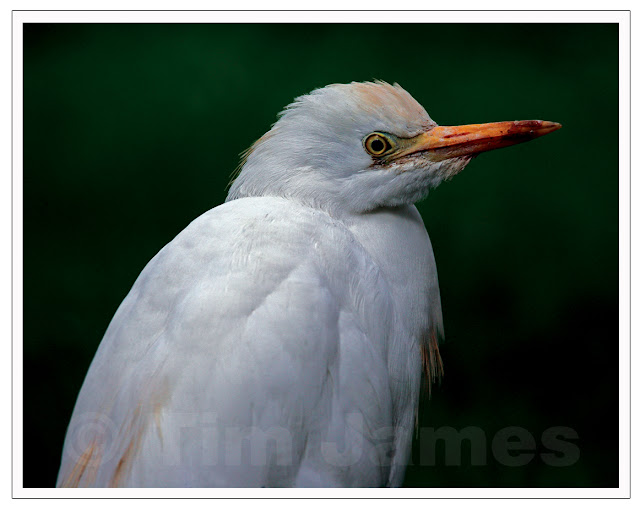 |
| Canon 1Ds MkII, Canon 100-400mm IS USM lens, 1/500th sec, f/9, 400mm at ISO 640 |
 |
| Canon 1Ds MkII, Canon 100-400mm IS USM lens, 1/160th sec, f/8, 400mm at ISO 500 |
 |
| Canon 1Ds MkII, Canon 100-400mm IS USM lens, 1/800th sec, f/5.6, 400mm at ISO 640 |
20110923
House Sparrow (Passer domesticus)
I adore these little birds. I think it's because their fearlessness and downright cheek make them a photographer's dream and their propensity to gather in large groups means there's always something going on.
 |
| Canon 1Ds MkII, Canon 100-400 IS USM lens, 1/800th sec, f/5.6, 400mm at ISO 640 |
 |
| Canon 1Ds MkII, Canon 100-400 IS USM lens, 1/250th sec, f/13, 400mm at ISO 640 |
 |
| Canon 1Ds MkII, Canon 100-400 IS USM lens, 1/400th sec, f/13, 400mm at ISO 640 |
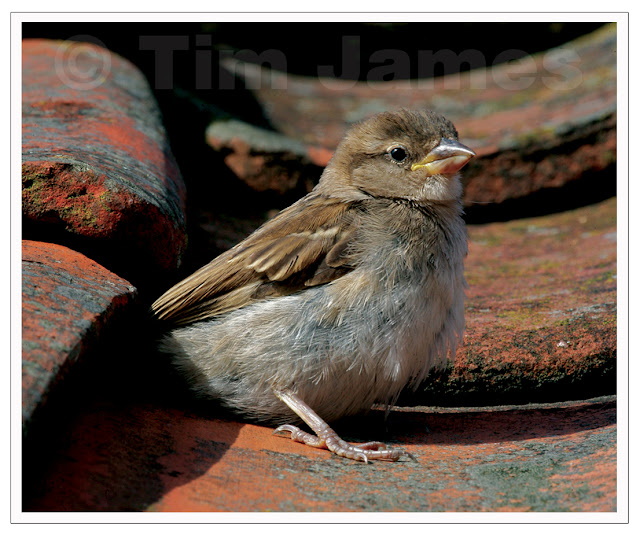 |
| Canon 1Ds MkII, Canon 100-400 IS USM lens, 1/100th sec, f/29, 400mm at ISO 640 |
20110922
Leaf in a Rainstorm (abstract) / Venice in Summer
When I saw these large raindrops gathering on a leaf with so much character, I had to stop to take the shot. This heavily treated interpretation is intended to have almost an HDR feel – high dynamic range. The effect is achieved by actually taking three exposures. The first is under-exposed by one or two stops; the second is exposed correctly; and the third is over-exposed by one or two stops. The three image files are then sandwiched together, with – effectively – the most visually distinctive elements of the first and last brought into relief within the correctly exposed version. The effect can be particularly compelling in portraits and landscapes and – although somewhat off-message for this blog (I hope you will forgive me) – I have attached a shot taken using the same technique during a day in Venice. If you study the picture for long enough, I'm sure you'll find a pigeon or two…


20110921
Bearded Reedling / Bearded Tit (Panurus biarmicus)
I had a fantastic day today at Pensthorpe, with dozens of shots to upload over the coming few days. I wanted, however, to post this one early. It was one of those shots when everything came together beautifully; a moment and an image to treasure. I had spent hours sitting patiently waiting for a decent shot of a male Bearded Reedling. Somehow, though, nothing was working very well; the birds were staying deep within the reeds, the sun was forever disappearing behind menacing clouds and, when I did get the chance of a shot, there always seemed to be stray foliage in the frame, spoiling either the detail or the composition. Then, however, this chap jauntily descended down a convenient reed stem just as the light became perfect. It dwelled just long enough and the result is, I think, a lovely portrait of a fabulous little bird. Check back for more over the next few days.
 |
| Canon 1Ds MkII, Canon 100-400mm IS USM lens, 1/160th sec, f/10, 400mm at ISO 500 |
20110919
A right royal robin rumpus
Labels:
Robin (Erithacus rubecula)
First of all, my apologies – I actually missed both of the shots below. The action happened very quickly and, at distance, the autofocus locked on to the foliage not the two robins. I've posted the images, however, because I think the story that accompanies them is one worth telling. I was sitting in the garden, simply waiting to see what might come into the bird feeders when suddenly there was quite a fuss coming from beneath a bush about 20 feet in front of me. Two robins were apparently locked in a tussle over territory. What surprised me, though, was the violence of the episode. First there was a brief stand-off, then they went at each other with quite some intent. The fighting – which was physical, not just posturing – moved from the grass to just above ground and, to my amazement, ended with one of the birds lying on its back motionless (see the inset image). The defeated robin could, of course, have been 'winded', but I suspect it was actually adopting a submissive pose in an attempt to bring the hostilities to an end. Certainly, after just a few seconds it righted itself and flew off, seemingly unhurt. Either way, I wish I'd managed to capture the episode but do feel privileged to have been given a glimpse into the life of the robin that was anything but picture postcard perfection.
 |
| Canon 1Ds MkII, Canon 100-400mm IS USM lens, 1/500th sec, f/5.6, 400mm at ISO 640 |
Garden Spider (Araneus diadematus)
Having recently documented in a rather cold fashion a couple of spider specimens, I thought I'd set out to capture one is a shot with a more artistic feel. This Garden Spider spinning its intricate web between gorse bushes provided a good opportunity. Worth clicking for the larger files to appreciate some of the web detail.
 |
| Canon 1Ds MkII, Canon 100-400mm IS USM lens, 1/400th sec, f/9, 400mm at ISO 400 |
 |
| Canon 1Ds MkII, Canon 100-400mm IS USM lens, 1/400th sec, f/10, 400mm at ISO 400 |
20110918
Woodpigeon
Labels:
Woodpigeon
Dragonfly
20110917
Woodpigeon (abstract)
Labels:
Woodpigeon
Sitting in the garden enjoying brief glimpses of warm September sunshine, I followed the activities of this Woodpigeon as it and a mate gathered twigs from the ground to build or shore up a nest in a nearby tree. The colours in the low sun were magnificent and it struck me that the myriad hues in the foliage behind the bird might make an interesting backdrop for a more abstract shot. I really like the result. For the technically minded, the shot is made possible by two key factors. The first is to close the aperture quite a bit (in this case all the way up to f/18) and bring the shutter speed way down, in no way attempting to freeze any of the action. In this example, the speed was reduced to just 1/30th of a second. The result – when one pans with the bird – is the streaming lines of the foliage behind the blurred movement of the subject. Anyone still awake?
 |
| Canon 1Ds MkII, Canon 100-400mm IS USM lens, 1/30th sec, f/18, 400mm at ISO 400 |
20110916
Male Adder (Vipera berus)
Labels:
Adder (Vipera berus)
I have decided to squeeze in as much Adder hunting time as I can spare over the coming few days. They'll soon be hibernating far out of view and, frankly, I will miss them. Today, early in the evening, with the sun low in the sky, there were few to be seen – only this male and a large female that disappeared before I even had time to raise my camera.
 |
| Canon 1Ds Mk II, Canon 100-400mm IS USM lens, 1/400th sec, f/5.6, 400mm at ISO 500 |
 |
| Canon 1Ds Mk II, Canon 100-400mm IS USM lens, 1/400th sec, f/5.6, 400mm at ISO 500 |
20110915
Adder (Vipera berus)
Labels:
Adder (Vipera berus)
The quality of this shot is pretty poor (the foliage between lens and subject rather spoils things and the adder was on the move and gone in a moment) but I've posted it because it's rewarding to have captured the detail of the flicking tongue as the reptile makes a chemical scan what may lie ahead. Despite warmish sunshine, the peak temperature today was 14ºC and this small male was my only sighting. Guessing it won't be long before they all tuck themselves away and wait for spring.
 |
| Canon 1Ds Mk II, Canon 100-400mm IS USM lens, 1/1,600th sec, f/5.6, 400mm at ISO 640 |
Common Darter (Sympetrum striolatum)
First of all, if I have the identification wrong on this specimen please do put me right. I am still trying to get to grips with the myriad similarities and differences. I was drawn to two aspects of this shot – the almost patriotic red cross colouring on the dragonfly's abdomen and the gorgeous detailing in its lacy wings. It was a lucky spot – as the September temperatures start to drop here in Norfolk there are fewer and fewer around.
 |
| Canon 1Ds MkII, Canon 100-400mm IS USM lens, 1/2,000th sec, f/5.6, 400mm at ISO 640 |
Grey Squirrel (Sciurus carolinensis)
I was hunting for adders this morning (one half-decent shot of a male will be posted later) when I heard the tell-tale sound of a squirrel discarding unwanted parts of acorns and dropping them noisily to the ground. When I spotted this female she was some distance away, but at a good height for a pleasing composition. I particularly like the animated eyes, the cradling of the acorn in surprisingly delicate claws and the way the bushy end of the animal's tail is visible below the branch she is perched upon.
20110910
Robin at Dusk
Labels:
Robin (Erithacus rubecula)
20110909
Giant House Spider (Tegenaria gigantea)
When my eldest son found this fine specimen, I couldn't resist a quick shot… (Sorry, no time for a manicure!)
20110907
Red-legged Partridge (Alectoris rufa)
With the game shooting season upon us, I thought I would try to capture a series of images of Red-legged Partridges. Although the local shoot is a mix of reared and wild birds, all of these images are of the latter, all but the first secured by lying down for long periods in the gap between lines of maize grown as a cover crop. While it's a shame the Red-legged or French Partridge now prevails so, with declining numbers of our own English or Grey Partridge, it is, I think, nevertheless an attractive bird and – inclined to gather in large coveys on the ground – a very sociable one too.
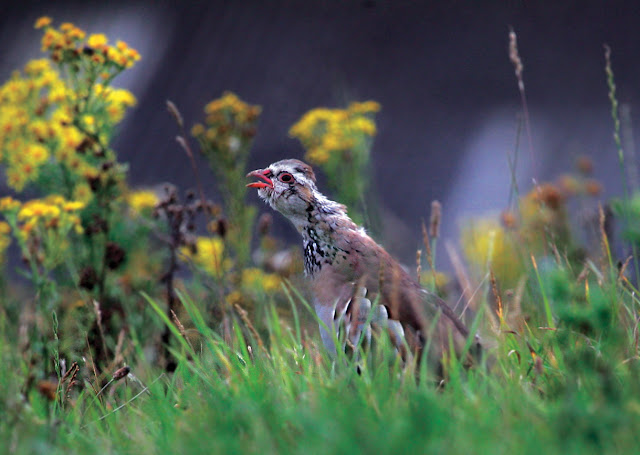 |
| Canon 1Ds MkII, Canon 100-400mm IS USM lens, 1/1,300th sec, f/5.6, 400mm at ISO 800 |
 |
| Canon 1Ds MkII, Canon 100-400mm IS USM lens, 1/1,000th sec, f/5.6, 400mm at ISO 500 |
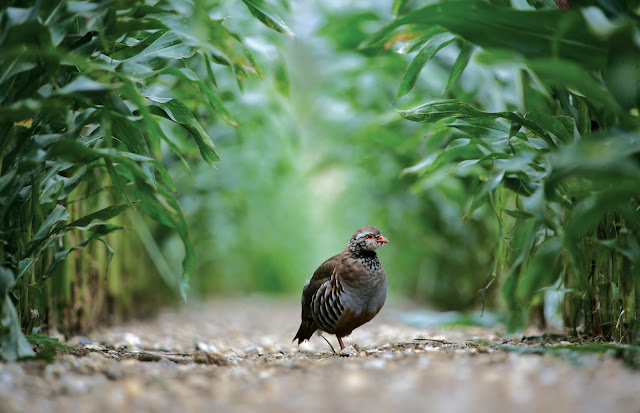 |
| Canon 1Ds MkII, Canon 100-400mm IS USM lens, 1/500th sec, f/5.6, 400mm at ISO 500 |
 |
| Canon 1Ds MkII, Canon 100-400mm IS USM lens, 1/400th sec, f/5.6, 400mm at ISO 500 |
 |
| Canon 1Ds MkII, Canon 100-400mm IS USM lens, 1/1,000th sec, f/5.6, 400mm at ISO 500 |
Subscribe to:
Posts (Atom)

















